Want to build your dream LinkedIn prospecting strategy? LinkedIn prospecting lets you harness the largest professional network in the world to source your potential customers.
Here are 13 expert ways to launch your lead generation on LinkedIn, from finding your prospects to building relationships that resonate.
TL;DR
- Get leads from profile posts: Extract people who have engaged with an influencer’s LinkedIn posts.
- Export LinkedIn newsletter subscribers: Find people interested in your industry through relevant industry-related newsletters.
- Extract LinkedIn profile data: Get to know your leads via their profiles.
- Use AI for lead qualification: Filter your leads to find the ones that count.
- Get AI-powered lead scores: Give scores to your leads based on their likelihood to convert.
- Personalize LinkedIn messages with AI: Nurture professional connections with tailored LinkedIn messaging.
- Get leads who commented on a post: Identify people already engaging with your brand (or a competitor).
- Gather prospects from a LinkedIn group: Export LinkedIn group members for your sales prospecting.
- Find prospects from a LinkedIn event: Connect with event attendees to reach the right audience.
- Purchase a LinkedIn Sales Navigator subscription: Get advanced search alert tools and more.
- Track job changes: Find out when someone moves to a new company and automatically update your CRM.
- Automate prospecting on LinkedIn: From social selling to optimized LinkedIn profile searches and beyond.
- Monitor LinkedIn sales prospecting trends: Keep ahead of the latest LinkedIn outreach and prospecting activities developments.
1. Find leads from relevant LinkedIn profile posts
Want to build relationships with the right people? Look for prospects who have already engaged with industry leaders or influencers in your niche. That way, you can use their LinkedIn posts to find high-potential leads.
We recommend doing this automatically via the LinkedIn Profile Post Commenter and Liker Scraper.
Our in-house PhantomBuster coach, Brian, has a tutorial video explaining how this works. You can also follow the steps below.
- First, share the LinkedIn profile URL that interests you.

2. Next, choose which type of post engagers you want to extract. You can choose between likers and/or commenters and decide which dates to get posts from.
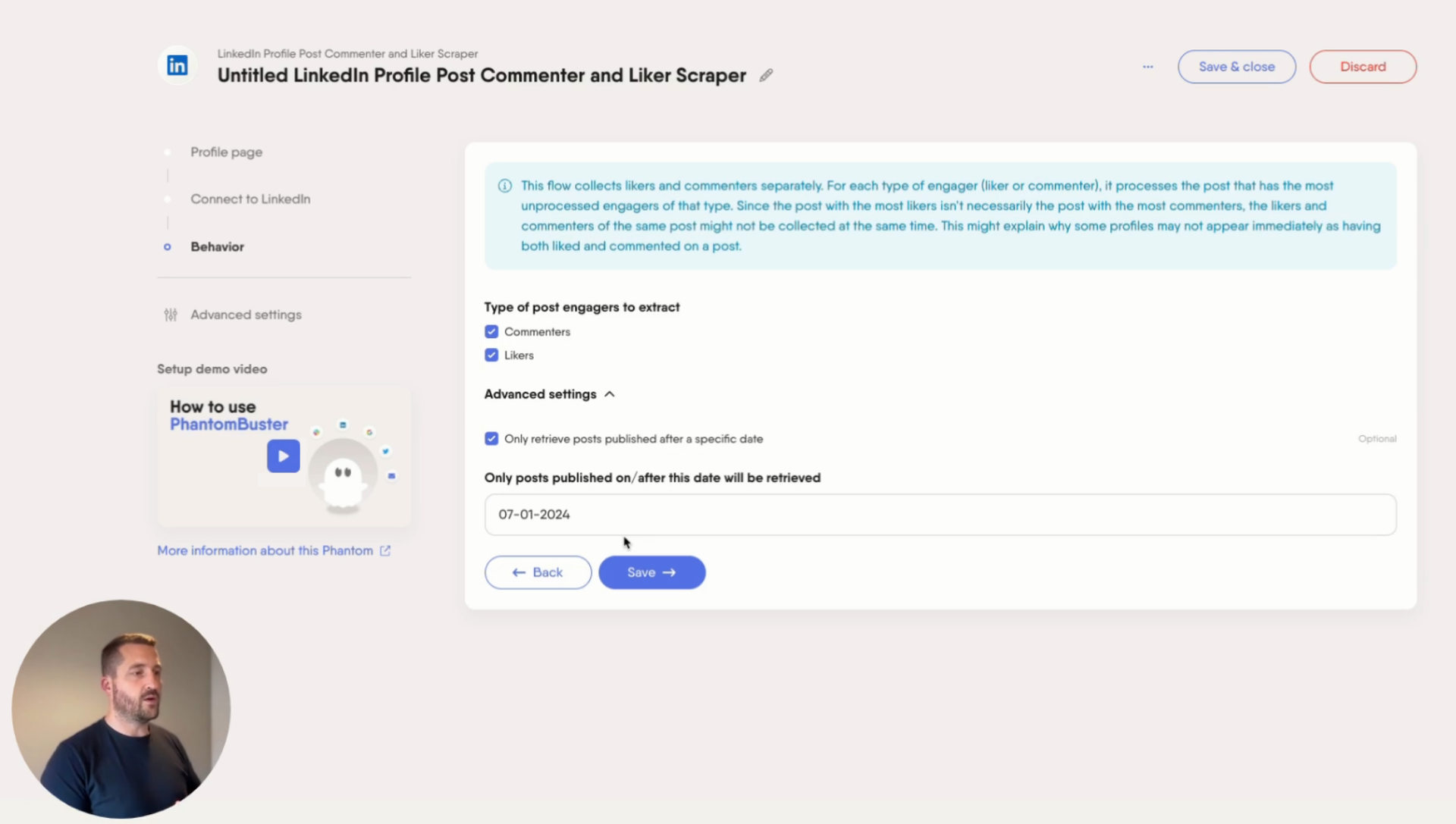
3. Launch the automation. And that’s it—you’ll get a report with a list of LinkedIn profiles, ready for you to send a connection request or to add to your lead management tools.

2. Export LinkedIn newsletter subscribers into Google Sheets
Exporting LinkedIn newsletter subscribers is another way to find people interested in a specific topic. And if you’re feeling a bit more technical, you can extract the full list in minutes.
In his video tutorial, our PhantomBuster Coach, Fabian, explains you have to:
- Click on the list of subscribers from the newsletter page.

2. Right-click ‘Inspect’ to open the dev tool, and select ‘Console.’
3. Paste this code into the console:
“””
test = document.querySelectorAll(“.reader-subscriber-list-item__actor-profile-link”)
result = []for (profiles of test) {
result.push(profiles.href)
}
copy(result)
“””

4. Copy the list of subscribers into a Google Sheet. There will be a comma at the end of each profile URL, but you can use the ‘Find and Replace’ function to remove these.
You’ll then have a list of LinkedIn profile URLs in a spreadsheet, ready to be enriched and nurtured.
3. Leverage LinkedIn data to enrich your inbound leads
Imagine you’ve got a list of new inbound sales leads and need to know them better. From location to employment history and contact details, LinkedIn profiles are packed with valuable information.
But how do you organize all that LinkedIn data? The LinkedIn Profile Scraper automation can help.
All you have to do is:
- Gather a list of LinkedIn profile URLs, paste them in a public Google Sheet, and share the spreadsheet link in the ‘Profiles to scrape’ section.
- Next, specify how many profiles to process, then launch the automation.

You’ll get an output file with all the publicly available LinkedIn data from each profile.
4. Use AI to clean your sales prospecting lists
With sales prospecting, you often end up with a big list of potential leads. But they won’t all be the right match!
First, you need to “clean” your sales prospecting list. This means filtering it down to the prospects who could be genuinely interested in your brand.
You can use AI to evaluate whether someone fits your ideal customer profile using a process known as lead qualification.
With PhantomBuster’s AI LinkedIn Profile Enricher, all you have to do is:
- Share a list of LinkedIn leads to analyze.
- Write your prompt, asking ChatGPT to filter profiles based on specific criteria.
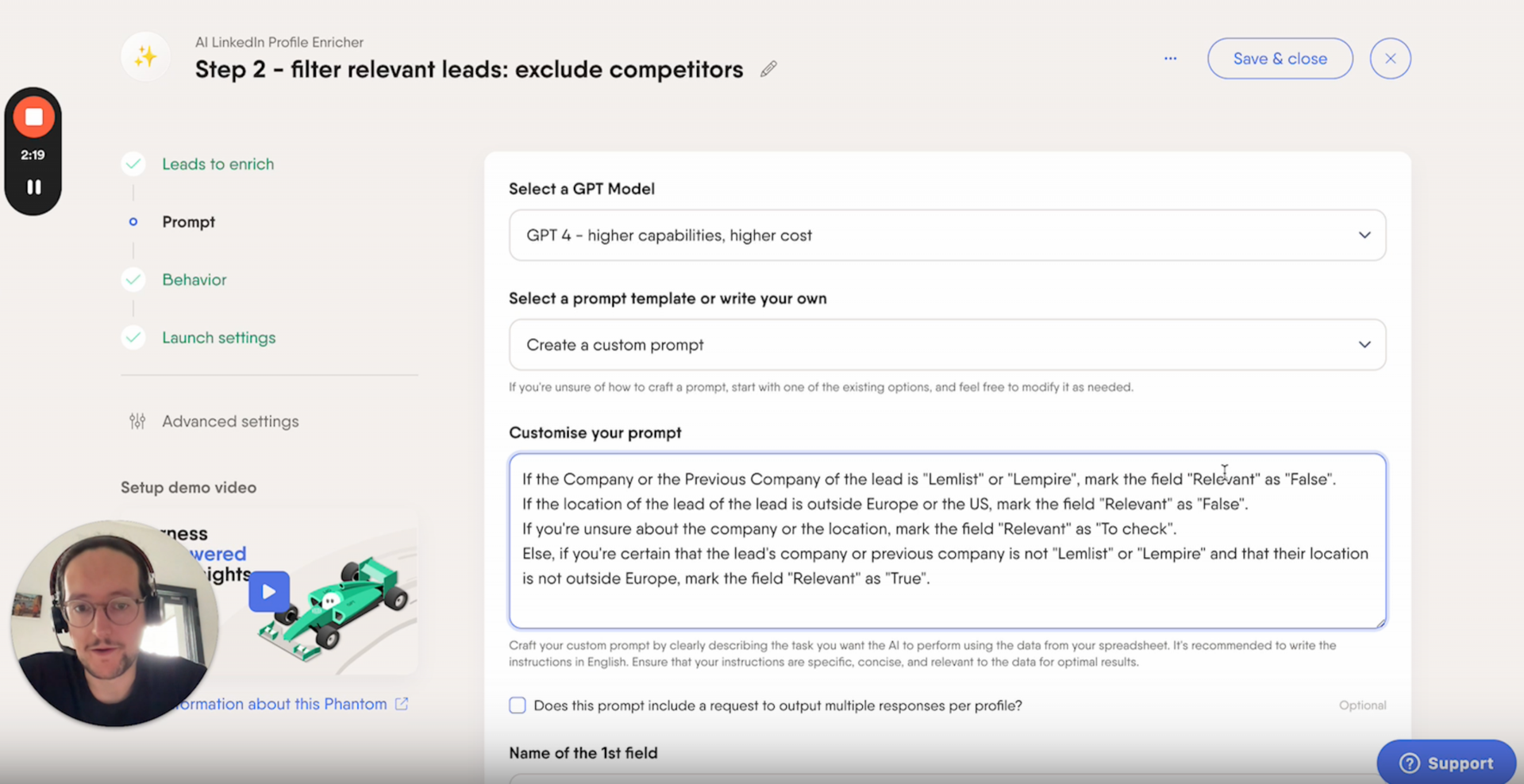
3. Launch the automation and get a list of qualified leads.
This lets you remove competitor profiles or irrelevant leads, for example.
5. Score your LinkedIn prospects using AI
To support the lead qualification process, you can also use lead scoring to assign a numerical value to each potential client based on specific criteria.
The higher the score, the more likely the person is to buy your product or service.
Using PhantomBuster’s AI LinkedIn Profile Enricher automation, you can:
- Share your list of LinkedIn leads.
- Write a prompt, explaining how each lead should be scored (e.g., if they have a certain role, or are based in a specific location).
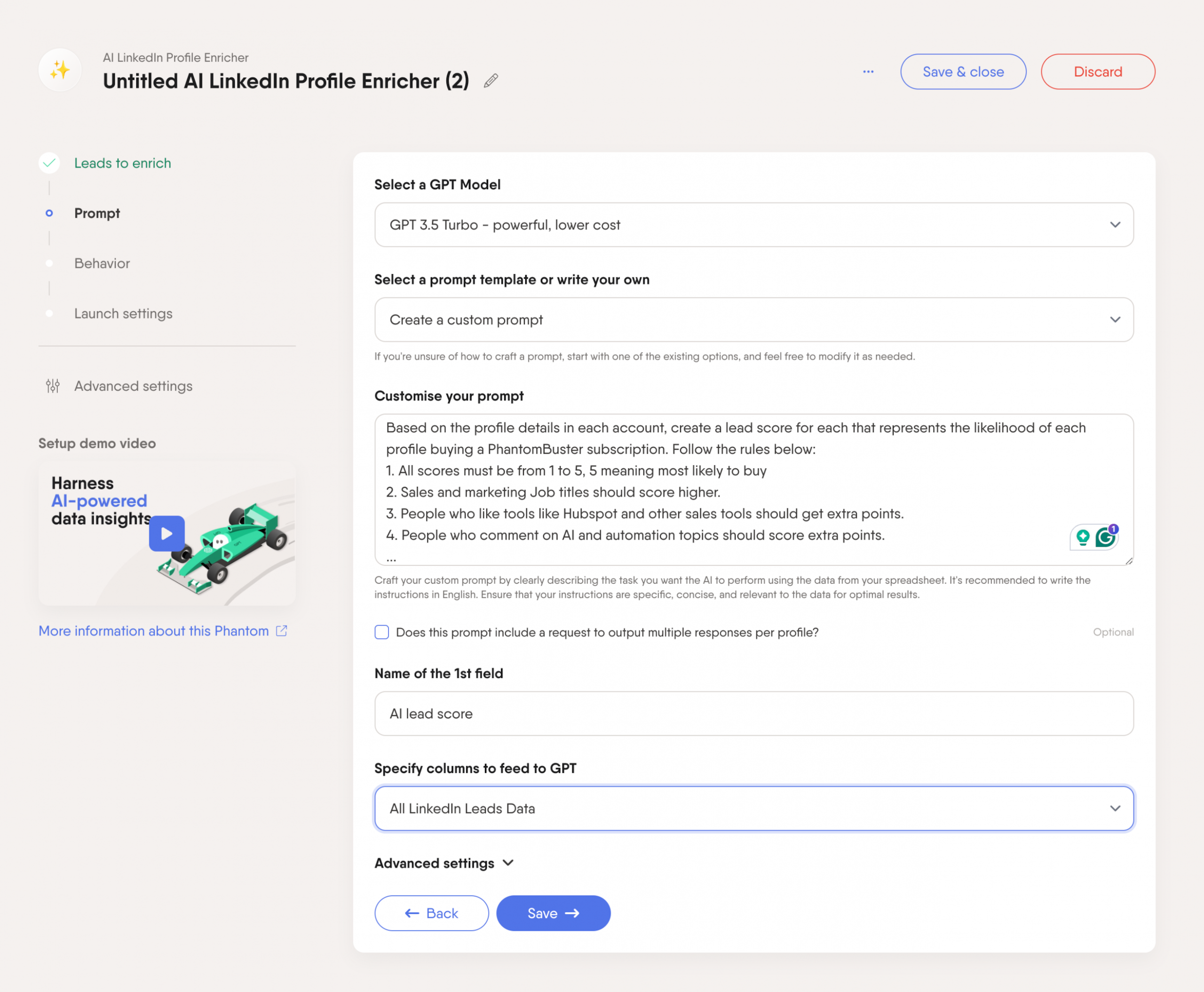
3. Launch the automation and get a list of lead scores.
This can streamline your prospecting efforts, enabling you to focus on the leads that count.
6. Personalize LinkedIn prospecting messages using AI
When it comes to building relationships, a LinkedIn messaging sequence could be the answer.
Instead of copy-pasting mass emails that all say the same thing or cold calling random numbers, you can use LinkedIn messages tailored to each buyer persona—with a little help from AI.
With the AI LinkedIn Message Writer, you can share a list of profiles, write out your prompt, and then get an AI-generated list of messages.

AI prompt examples
Are you looking for the perfect ChatGPT prompt to grow your LinkedIn network? Here’s a template for a LinkedIn connection request.
Write a LinkedIn connection message based on the LinkedIn profile data fed to you, the below context, format and content:
Context:
– LinkedIn connection messages must be limited to 280 characters,
– My name is <your first name>, and I work as a <your job title> at <your company name>,
– I am looking to connect with interesting and experienced professionals to expand my network and stay in touch with them,
– I do not possess similar experience and skills to them,
– I am not looking to offer them any services or recruit them.
Format of your message:
– must contain less than 280 characters,
– must be written in English,
Content of your message:
– must quote one or two data points from the profile,
– must be written in a fun, casual way,
– must not use the word “fellow”.
Here is an example of a good connection message:
“Hey Ben! Impressed by your experience leading sales teams at GoodProduct Inc. Would love to connect and learn more about your expertise in business development and SaaS. No sales pitch, just a curious recruiter expanding his network!”
The message must be shorter than 280 characters. If the message is longer than 280 characters, rewrite it to be shorter than 280 characters.
When preparing your own AI prompts, our PhantomBuster Coach and lead generation expert Brian recommends following this structure:
- Objective: Explain what you want to do.
- Context: Give all relevant background information.
- Personas: Describe who you are, and list your buyer personas’ characteristics.
- Instructions: Give specific instructions on how to generate the LinkedIn messages (e.g., input data that can be used to personalize the message, message length, etc.).
- Format: Detail the messages’ structure, such as using paragraphs and bullet points.
- Tone: Describe how you want the message to sound.
- Examples: Give an example of a successful message for the AI model to follow.
You can access Brian’s full insights here.
LinkedIn message examples
Here are some examples of successful LinkedIn messages that sales reps can use.
For instance, this cold message finds common ground to promote a new resource.
Hey [First Name],
As we both work in [Industry], I was wondering if you’d be interested in [Resource or Product]. Let me know if you’d find that helpful, and I’ll forward you the link.
Have a great day,
[Your Name]

This LinkedIn connection message uses information about someone’s comment history to build a rapport.
Hi [First Name],
I saw your comment on [Post Topic] and found your perspective on [Specific Point] really interesting. I’d love to connect and discuss this further!
Have a great day,
[Your Name]

7. Collect leads who’ve interacted with your competitors’ content on LinkedIn
Intent data shows who is actively interested in your brand, product, or industry. These people are the most likely to respond positively to your sales pitch.
You can look at who’s engaging with specific LinkedIn posts, whether your own or your competitors’ content.
We recommend using the LinkedIn Post Commenters Export automation:
- Share a list of LinkedIn posts with relevant content via a public Google Sheet URL.
2. Choose your settings, then launch the automation.
You’ll get a list of LinkedIn users who commented on the post(s), along with their comments. These profiles could be potential prospects!
8. Extract qualified leads from relevant LinkedIn groups
Joining groups is a great place to start if you’re looking for a pool of leads in your niche.
LinkedIn groups are online forums where people can talk about specific industry topics. From there, you can export a list of group members to generate leads.
Once you’ve joined relevant groups that match your buyer personas’ interests, you can use the LinkedIn Group Members Export automation to extract the new prospects’ profiles.
Here’s how:
- Join the LinkedIn group(s) that are relevant to your brand.
- Share the group URL or a list of groups to scrape using a public Google Sheet URL if you want to process multiple groups at once.
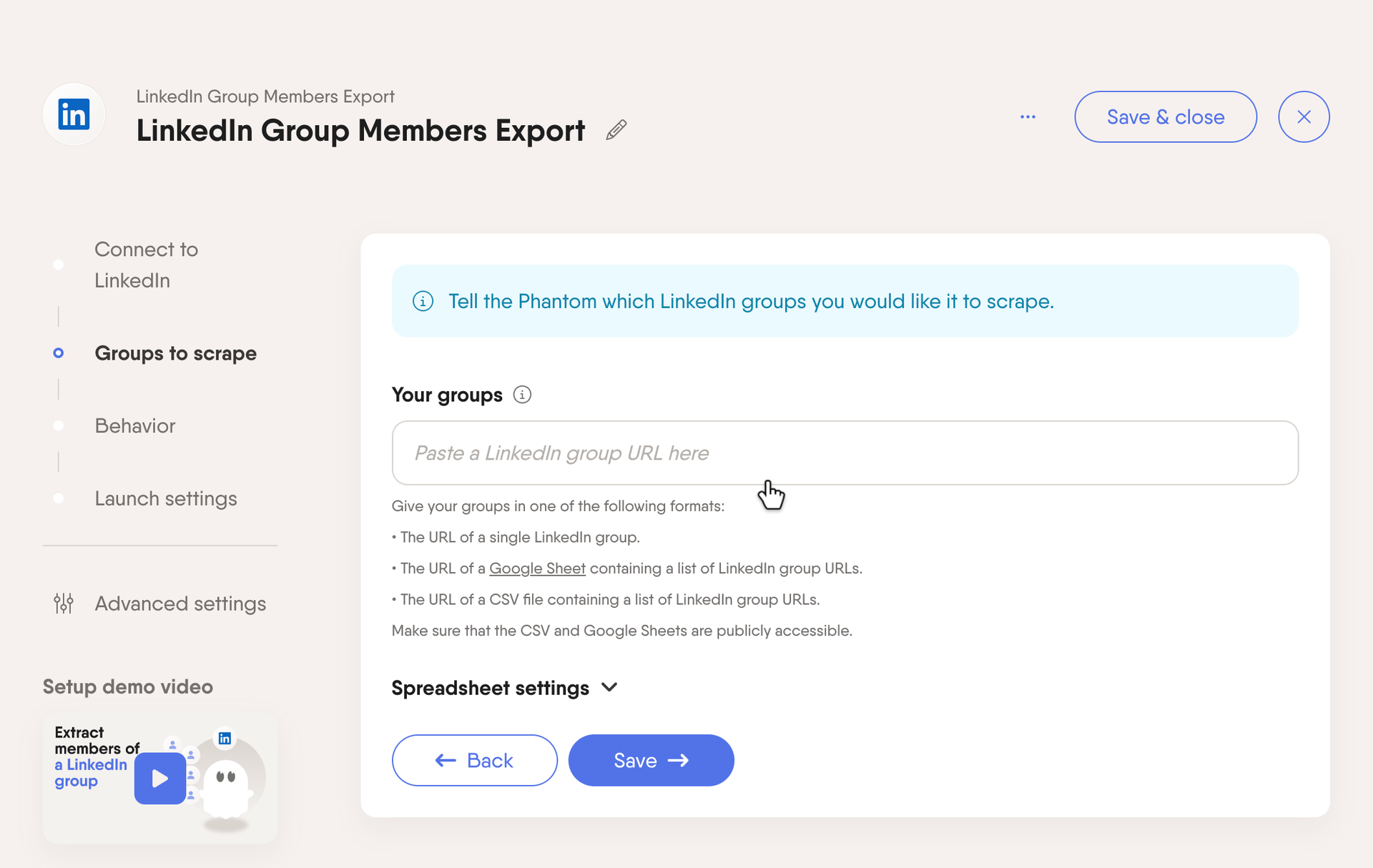
3. Choose your settings, then launch the automation.
You’ll then have a fresh list of LinkedIn leads for the next step in your sales prospecting workflow.
9. Collect attendees from your competitors’ LinkedIn events
LinkedIn events are online seminars—and another valuable source of potential customers.
You can find LinkedIn events associated with your industry, such as competitors’ events, and then send connection requests to the attendees.
But how do you find their profiles? PhantomBuster’s LinkedIn Event Guests Export has you covered:
- Share the URL(s) of the LinkedIn event(s) you want to process (you must be an attendee to do this).
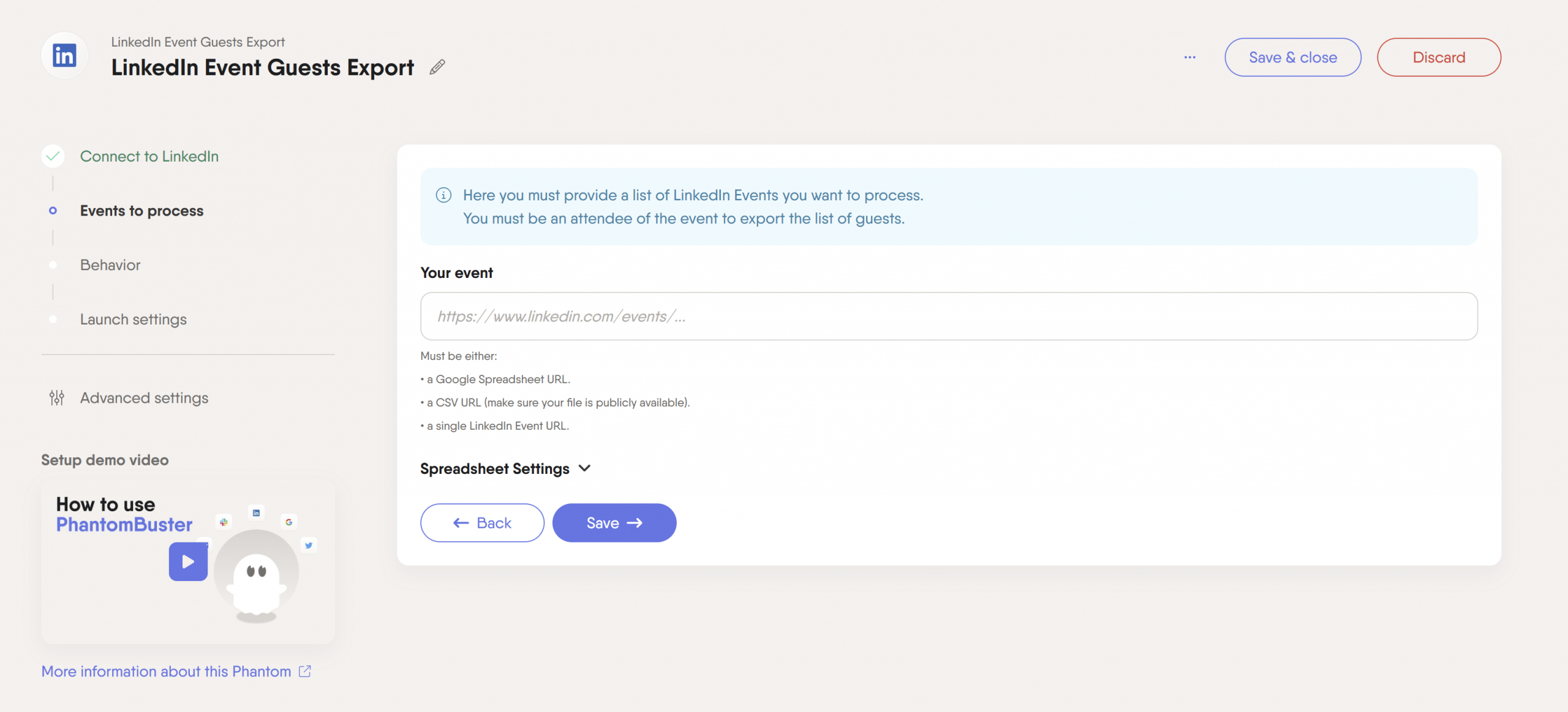
2. Choose your settings, then launch the automation.
You’ll get a list of LinkedIn event attendees who are guaranteed to be interested in your niche.
10. Invest in a LinkedIn Sales Navigator account
LinkedIn Sales Navigator is a premium account type, allowing you to:
- Get advanced search superpowers: Enjoy high-level LinkedIn search filters.
- Create prospect lists: Target companies and individuals with the right buyer personas.
- Get LinkedIn’s search alerts: Get notified about changes to your saved leads and accounts.
You can also automatically export data from LinkedIn Sales Navigator with the Sales Navigator Search Export automation.
Simply copy your search URL, paste it into the automation, and then you can download the search results on autopilot.
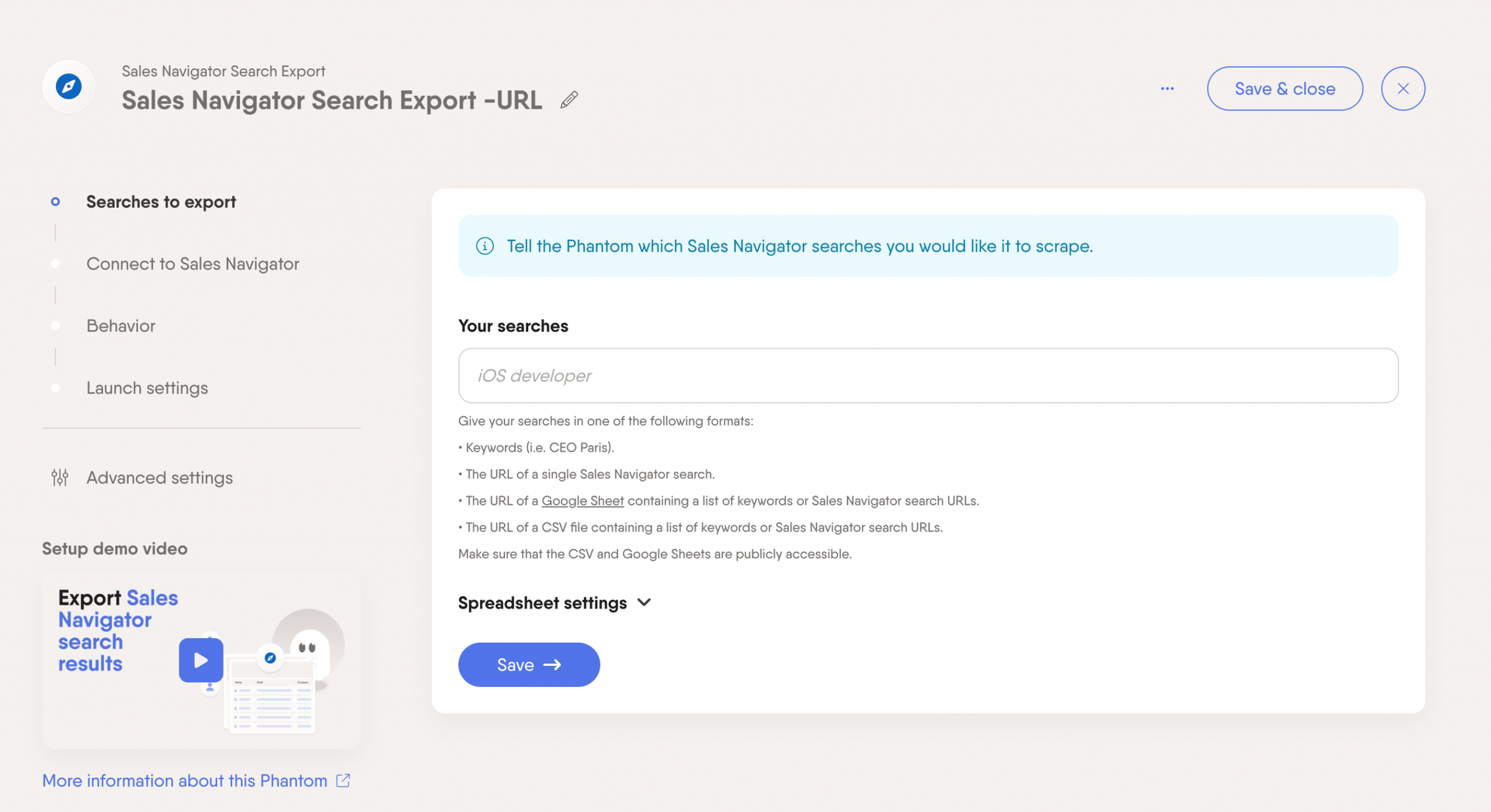
Plus, you can synchronize your Sales Navigator data with your CRM using the HubSpot Contact Sender. Choose which data to send, select your launch settings, and this automation will handle the rest.

11. Automatically track contacts who have recently changed jobs
What if your leads move to a new company? They may no longer be relevant prospects, but their job change could also open new business opportunities.
Fortunately, you can easily track job changes and update your CRM using the HubSpot Contact Career Tracker.
![]()
This tool monitors your HubSpot contacts and alerts you when someone switches companies, so you’re always aware of new sales opportunities.
12. Automate your LinkedIn prospecting process
Finding people who will appreciate your value proposition can take time. But automating your LinkedIn prospecting makes it much easier.
With automation, you can:
- Download LinkedIn search results on autopilot.
- Scrape engagement signals for social selling workflows, such as with PhantomBuster’s LinkedIn Auto Liker.
- Create an automated LinkedIn outreach sequence to build relationships at scale.
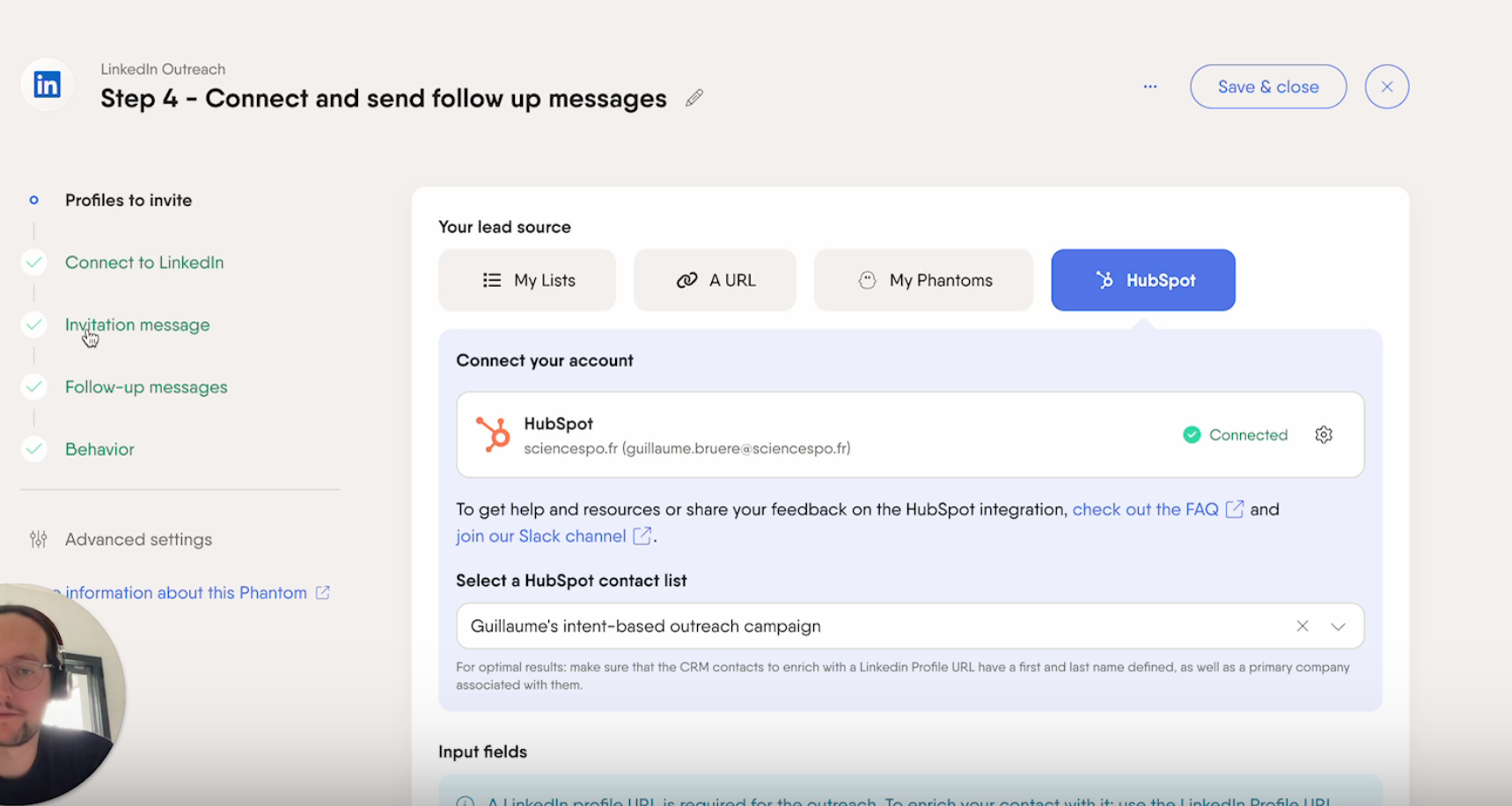
13. Stay up-to-date with the latest trends and tactics on LinkedIn prospecting
Follow LinkedIn’s latest sales prospecting trends to stay ahead of the game. There are many sales resources, events, and webinars available for sales reps.
If you’re wondering where to start, we recommend PhantomBuster’s webinars, which include automation tips, plus exclusive sessions with our Coaches.

Besides, our Head of Marketing, John Mears, recently hosted a webinar on how to personalize LinkedIn outreach. This might help you sharpen your approach and connect better with your audience.

How PhantomBuster can help automate the LinkedIn prospecting process
PhantomBuster is a lead generation and prospecting software, great for extracting warm leads from LinkedIn and automating outreach efforts.
Here are some key features to boost your prospecting efforts on LinkedIn:
- Exporting LinkedIn search results on autopilot: Automatically find potential prospects on LinkedIn.
- Intent-based lead generation: Connect with prospects who show genuine interest, bringing in higher-quality leads.
- Lead enrichment through data scraping: Pull valuable LinkedIn data to fill your CRM with verified contact details.
- AI-powered lead scoring: Score your leads based on their likelihood to convert.
- Automated workflows: Set up automation for tasks like sending connection requests.
- HubSpot integration: Keep your CRM current by syncing contact info with minimal manual work.
Conclusion
Sales prospecting on LinkedIn can be time-consuming.
But with the right automation tools, you can quickly scale your outreach and prospecting activities—and free up time to build real relationships with your leads.
Try PhantomBuster free for 14 days to easily find prospects and build strong professional relationships on LinkedIn.
